How Well Do Solar Batteries Work To Store Solar Energy?
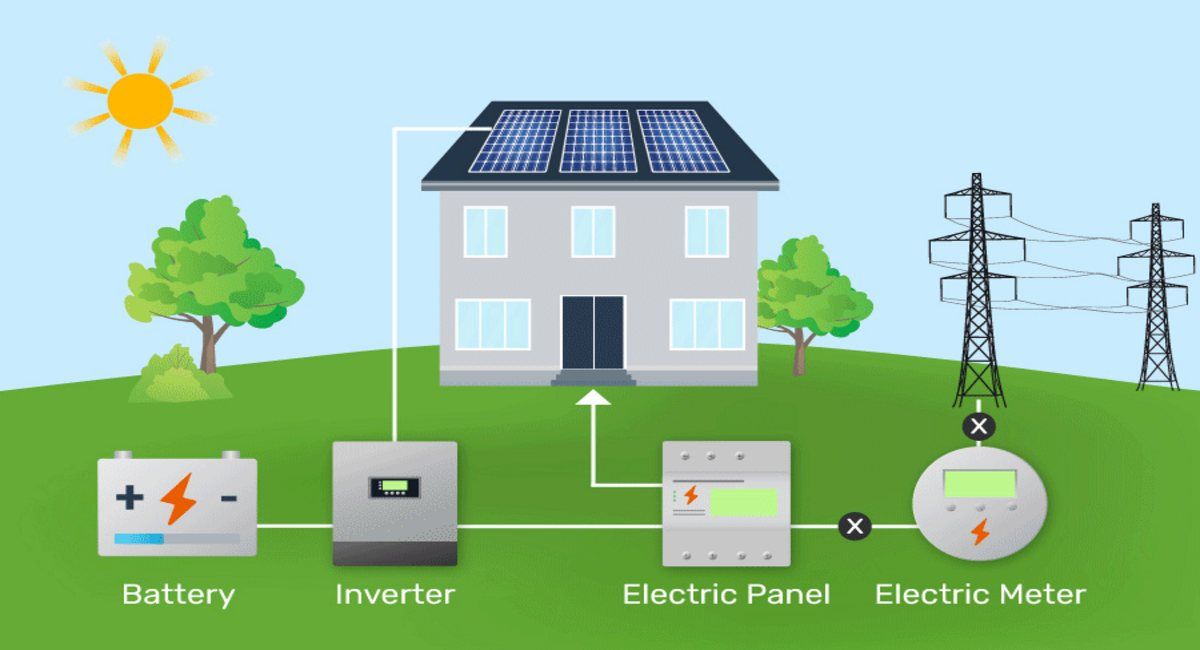
What is a Solar Battery?
A solar battery is a type of battery that stores energy generated by a solar PV system. The panels of the system capture solar energy and convert it to electricity, which is then routed through the inverter and used by your home. A battery is an extra component that allows you to store energy generated by your panels and use it later, such as in the evening when your panels are no longer producing electricity.
Unless you have an off-grid system, your solar PV system is connected to the power grid, allowing your home to continue receiving power even if your panels aren't producing enough to fulfill your energy needs. When your system's output exceeds your energy usage, the extra energy is transmitted back to the grid, a practice known as "net-metering." When this occurs, you will receive a credit on your next power statement, reducing your payment amount. Solar batteries, on the other hand, may be a terrific addition to a solar PV system for individuals who live off-grid or prefer storing extra energy rather than sending it back to the grid.
A solar battery's purpose is to let you use more of the solar energy you generate. If you don't have battery storage, any surplus electricity generated by solar panels is sent into the grid, which means you're creating power and distributing it to others without fully utilizing the electricity generated by your panels.
The Science Behind Solar Batteries:
Lithium-ion batteries are the most common type of solar battery on the market today. This is the same technology that powers cell phones and other high-tech devices.
Lithium-ion batteries function by storing chemical energy before converting it to electrical energy via a chemical process. The process takes place when lithium ions emit free electrons, which flow from the negatively charged anode to the positively charged cathode.
The lithium-salt electrolyte, a liquid within the battery that balances the reaction by delivering the required positive ions, encourages and enhances this movement. This flow of free electrons generates the current required for humans to utilize electricity.
When you take power from the battery, lithium ions travel through the electrolyte to the positive electrode. Simultaneously, electrons go from the negative electrode to the positive electrode via the outside circuit, powering the plugged-in device.
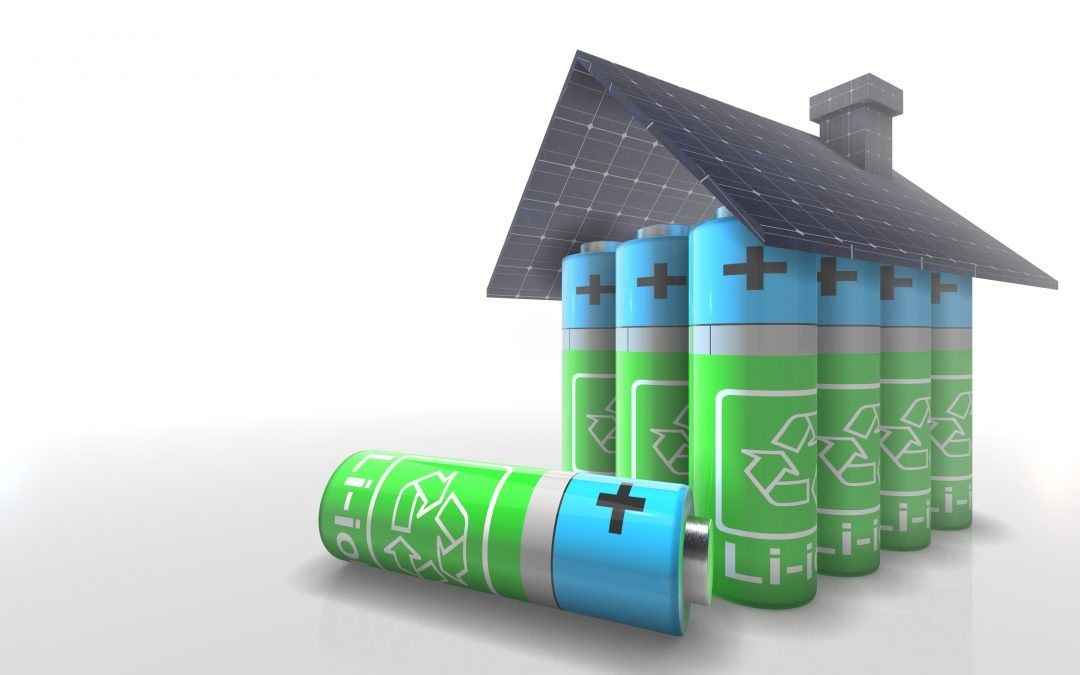
Home solar power storage batteries are made up of numerous ion battery cells and sophisticated electronics that control the overall performance and safety of the solar battery system. As a result, solar batteries work as rechargeable batteries that use the power of the sun as the first input that kickstarts the entire process of producing an electrical current.
How Do Solar Batteries Work?
In brief, battery storage works by storing surplus solar energy generated by the PV system for use at night. With current export tariffs at such low levels, this provides even more savings and becomes a highly lucrative long-term investment. Another notable benefit of storage systems is that they safeguard your home from power interruptions and help to reduce reliance on grid supplies.
- Solar panels convert sunlight into direct current power.
- The inverter transforms this to alternating current (AC), which is used by household appliances during the day.
- The excess electricity produced by the panels, which would normally be sent into the grid, is used to charge the batteries.
- When the batteries are fully charged, the leftover solar energy is exported to the grid in the normal manner.
- The stored energy in the battery is used during the night, guaranteeing little reliance on the grid.
Types of Solar Batteries:
Lead Acid Batteries:
Lead acid batteries are the tried-and-true technology in the area of solar batteries. Deep-cycle batteries have been used to store energy for a long time, dating back to the 1800s. And they've been allowed to stay because of their dependability.
Lead acid batteries are classified into two types: Flooded Lead Acid Batteries and Sealed Lead Acid Batteries.
The following are some of the most popular lead acid batteries accessible to homeowners:
- Trojan J185E-AC Deep Cycle Flooded Lead Acid Battery
- Crown Battery’s Crown1 absorbent glass mat (AGM) Sealed Lead Acid Battery
- Deka Solar’s 8g30H Gel sealed lead acid battery
Pros:
Lead acid batteries are the least expensive kind of energy storage, making them the most cost effective. They are also trustworthy. Furthermore, because the technology has been around for a long time, they are readily disposed of and recycled.
Cons:
Flooded lead acid batteries require ventilation and frequent maintenance to function properly, which increases the likelihood of the battery leaking.
Because flooded lead acid batteries cannot be installed on their side, this restricts how they may be mounted. They also have a low depth of discharge (DoD), which necessitates more frequent charging.
Because they have a low depth of discharge, they have a shorter lifespan - between 5 and 10 years.
Lithium-Ion Batteries:
Lithium-ion batteries are the newest additions to the energy storage family. As the popularity of electric vehicles grew, EV manufacturers recognised the promise of lithium ion as an energy storage solution. They immediately rose to prominence as one of the most extensively used solar battery banks.
The following are the most popular lithium-ion solar batteries:
- Tesla’s Powerwall battery
- LG’s Chem RESU lithium ion battery
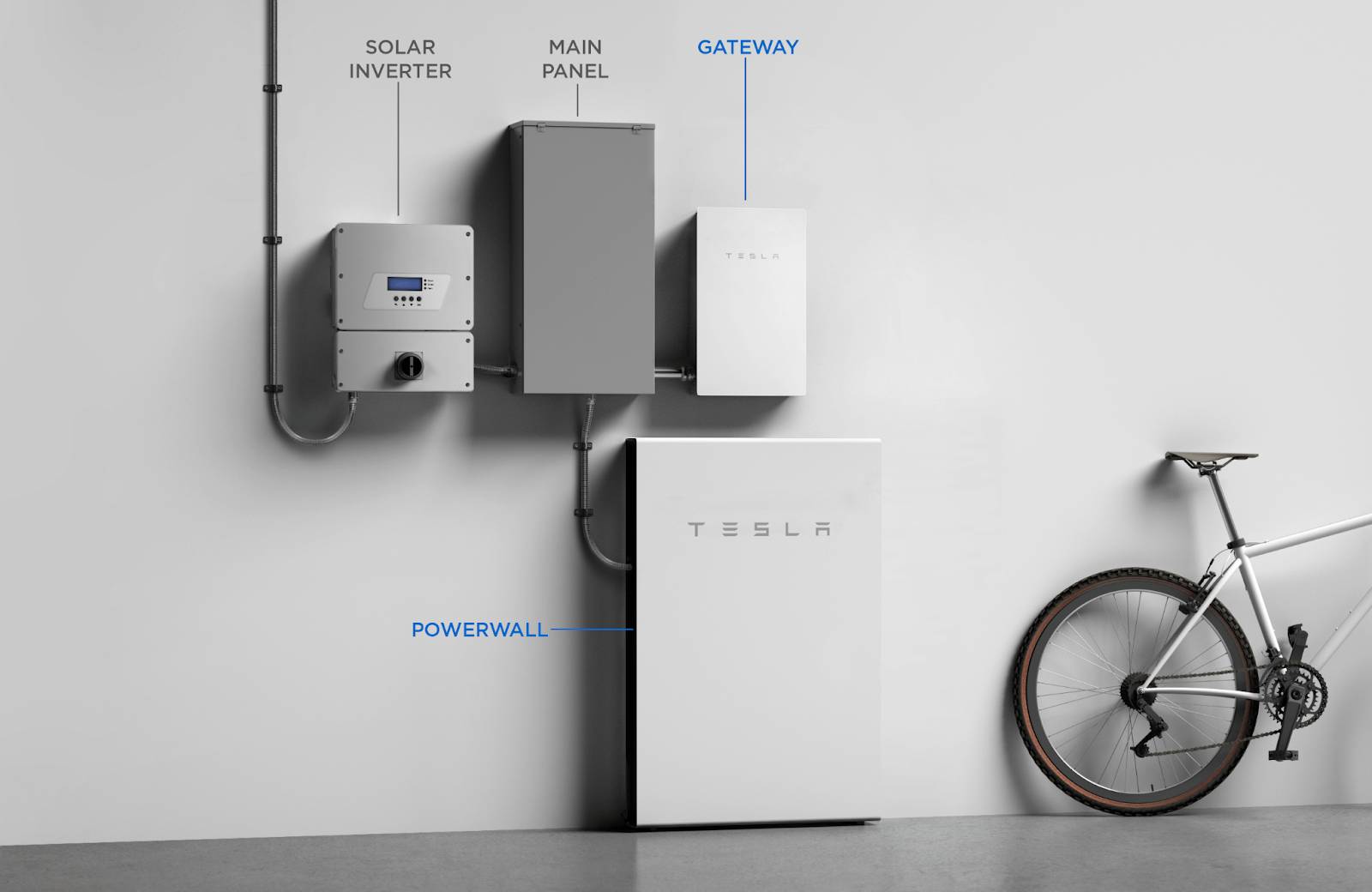
Pros:
Lithium-ion batteries practically never need to be serviced on a regular basis.
They also have a greater battery energy density than lead-acid batteries, which means they can store more energy in a smaller space.
Most lithium ion batteries also have a longer life cycle, or longevity, and most have a guaranteed warranty of at least ten years. This extended lifespan is due to lithium ion batteries' deeper depth of discharge, which allows you to use more of the energy contained inside the battery before it has to be recharged.
Cons:
One of the most significant downsides of lithium ion batteries is their higher cost than other energy storage technologies.
Furthermore, because of their chemistry, lithium-ion storage devices have a higher risk of catching fire due to a phenomenon known as thermal runaway. However, if your battery is correctly fitted, the chances of it catching fire are almost zero.
Nickel Cadmium Batteries:
Nickel cadmium (Ni-Cd) batteries are less common than lead acid or lithium ion batteries.
Ni-Cd batteries first appeared in the late 1800s, but they were given a makeover in the 1980s that dramatically boosted the amount of energy they could store. They are popular in the aerospace industry.
Pros:
The fundamental advantage of Ni-Cd batteries is their long life. They are also capable of operating at high temperatures. Furthermore, they do not need sophisticated battery management systems and are almost maintenance-free.
Cons:
The most serious disadvantage of Ni-Cd batteries is that cadmium is exceedingly poisonous.
In fact, several nations prohibit the use of cadmium. As a result, they are difficult to dispose of. They are also susceptible to the memory effect, which reduces their capacity to maintain a charge.
Flow Batteries:
Flow batteries are a new technology in the energy storage industry.
They contain a water-based electrolyte liquid that flows between the battery's two distinct chambers, or tanks. When charged, chemical processes take place, allowing the energy to be stored and then expelled. These batteries are becoming increasingly popular.
Because of their larger size, they are more costly than other battery kinds. The exorbitant price, along with their vast size, makes them difficult to adapt to household use.
Pros:
Flow batteries offer a 100-percent depth of discharge, which is one of their finest features. This implies that you may use all of the energy contained in the battery without endangering its health.
Because the liquid within the battery is also fire retardant, there is no chance of thermal runaway. Flow batteries have the longest duration on our list, with a lifespan of 30 years! They're also low-maintenance, which is a plus.
Cons:
Unfortunately, flow batteries are substantially more costly than other forms of solar batteries. They also have a very low storage capacity when compared to other battery systems, so they must be huge in order to retain a significant quantity of energy.
They have very low charge and discharge rates, which implies they must be huge in order to be effective.
AC Coupled Storage vs. DC Coupled Storage:
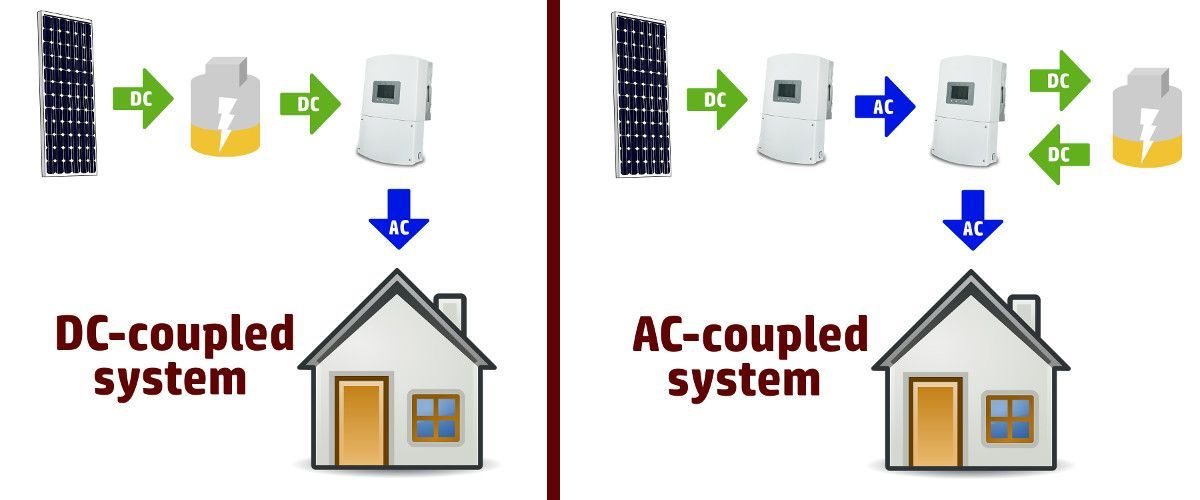
Your solar panels are connected to your battery storage system, and you have two options: Direct Current (DC) Coupling or Alternating Current (AC) Coupling.
The key distinction between the two is the path that the power generated by the solar panels takes.
Solar cells generate direct current (DC), which must be converted into alternating current (AC) before it can be used by your home. However, because solar batteries can only store direct-current electricity, there are several methods to integrate a solar battery into your solar power system.
DC Coupled Storage:
When DC coupling is used, the DC power generated by solar panels passes through a charge controller and then straight into the solar battery. There is no current shift before storage, and the battery only converts from DC to AC when it feeds power to your house or back into the grid.
Because the power only needs to transition from DC to AC once, a DC-coupled storage battery is more efficient. DC-coupled storage, on the other hand, often necessitates a more sophisticated installation, which can raise the initial cost and delay the whole installation duration.
AC Coupled Storage:
With AC coupling, the direct current (DC) power generated by your solar panels is turned into alternating current (AC) electricity for usage by appliances in your house. That alternating current electricity can also be sent to a separate inverter and converted back to direct current for storage in the solar battery. When it's time to use the stored energy, it flows out of the battery and into an inverter, where it is transformed back into alternating current (AC) power for your house.
When using AC-coupled storage, power is reversed three times: once from your solar panels into the house, once from the house into battery storage, and once from battery storage back into the house. Because each inversion causes some efficiency losses, AC-linked storage is somewhat less efficient than DC-coupled storage.
Unlike DC-coupled storage, which can only store energy from solar panels, AC-coupled storage can store energy from both solar panels and the grid. This implies that even if your solar panels aren't producing enough electricity to fully charge your battery, you may still fill it with grid electricity to offer backup power or to take advantage of electricity rate arbitrage.
It is also simpler to enhance your existing solar power system with AC-coupled battery storage since it may be installed on top of an existing system design rather than be incorporated into it. As a result, AC-linked battery storage is becoming a more common alternative for retrofit installations.
How Solar Batteries Work With A Solar Inverter?
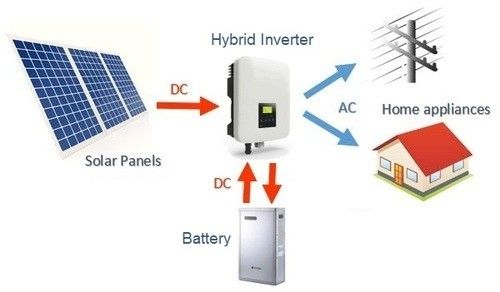
A hybrid inverter is a single device that can convert DC power into AC electricity as well as AC electricity into DC electricity. As a consequence, your photovoltaic (PV) system does not require two inverters: one to convert power from your solar panels (solar inverter) and another to convert electricity from the solar battery (battery inverter).
The hybrid inverter, also known as a battery-based inverter or hybrid grid-tied inverter, combines a battery inverter and a solar inverter into a single piece of equipment. By acting as an inverter for both the power from your solar battery and the electricity from your solar panels, it removes the need for two separate inverters in the same system.
Hybrid inverters are becoming more popular since they can operate with or without battery storage. During the initial installation of your battery-less solar power system, you may install a hybrid inverter, giving you the option of later adding solar energy storage.
3 Key Advantages of a Solar Battery:
Stores Excess Electricity Generated:
On bright days when no one is at home, your solar panel system may often provide more electricity than you use. Extra energy will be transmitted to the grid if you do not have solar energy battery storage. If you engage in a net metering scheme, you can get credit for the excess generation, but it isn't always a 1:1 ratio for the power you create.
Instead of flowing to the grid, the surplus power charges up your battery for later usage using battery storage. You may use the saved energy during periods of lower generation, reducing your dependency on the grid.
Great Power Backup Solution:
Because your batteries can store surplus energy generated by your solar panels, your home will have power during power outages and other times when the grid is down.
If you don't have any battery storage when the sun goes down and your solar panels stop producing electricity, the grid steps in to give you much-needed power. You'll use more of your own solar electricity at night with a solar battery, offering you more energy independence and helping you keep your electric bill low.
Reduces Your Carbon Footprint:
You can go green by maximizing the clean energy produced by your solar panel system with solar panel battery storage. If you don't store that energy, you'll have to rely on the grid when your solar panels don't generate enough to meet your demands. However, because most grid electricity is generated using fossil fuels, you will most likely be utilizing dirty energy while pulling from the grid.
Wrapping Up:
Solar panels are progressively replacing traditional sources of electricity as the globe embraces "green energy." Solar batteries are critical in ensuring that you have a consistent power source in your house. AC-couple storage batteries include an inverter that changes the electric current, depending on the direction, to DC or AC. A DC-coupled battery, on the other hand, does not have this property. Regardless of the configuration, both batteries store electric energy in DC. The rate at which power is stored in the batteries is determined by the size of the panels and the quantity consumed by your household appliances.
The prospect of having an energy-independent house is appealing to any homeowner. It has several advantages, the most important of which is that you will not be harmed by variations in utility rates. You will also be pushing the "green energy" campaign, which is now being advised as a method of environmental preservation. Fortunately, given the tremendous advancements in the realm of energy storage, it is a reachable ambition. To meet your demands, all you need is a set of solar panels or a solar structure design software, as well as a battery backup.

